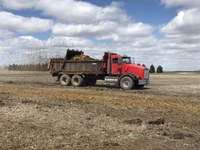Consider Manure as a Fertilizer
(Click the image below to view a high-resolution image that can be downloaded)
This long, cold winter has many considering using manure as a fertilizer. With the continuous rise of fertilizer prices and prolonged supply chain issues, bedded-pack beef manure can be a cost-effective solution, according to North Dakota State University (NDSU) Extension livestock environmental management specialist, Mary Keena.
“Although it is commonly thought of as a waste, manure contains nutrients such as nitrogen, phosphorus, potassium and sulfur that are available at various rates for plant growth,” says Keena.
Besides the bump in fertility, there are other benefits to using manure in your cropping system. Manure has been shown to increase water holding capacity and bulk density along with improving biological properties of the soil.
“Manure has many positive attributes, but it also has some drawbacks, says Keena. “One of the drawbacks is lack of uniformity and another is the issue of weed seed management. While it is true that manure contains viable weed seeds, it is also true that manure contains the nutrients necessary to nourish the weed seed bank that already exists in your soil. Nonetheless, composting can help alleviate both of these problems at the same time.”
Composting is the process of piling and mixing moistened manure to encourage thermophilic decomposition. The heat that is created during the composting process has the ability to kill weed seeds, pathogens and parasites while creating a uniformly mixed product with alike surface area. Composting manure also changes the availability of nitrogen for plant use, turning it into a slower-release product. NDSU Extension publication NM1478, “Composting Animal Manures” is a guide to the process and management of animal manure compost. The publication is available at www.ndsu.edu/agriculture/extension/publications/composting-animal-manures-guide-process-and-management-animal-manure-compost/.
“The nitrogen in fresh beef manure is approximately 50% available for plant growth during the first growing season after application, whereas the nitrogen in composted beef manure is only 15% to 20% available,” says Keena. “Most often, fresh manure is used as a nitrogen fertilizer while composted manure is used as a phosphorus fertilizer because phosphorus is approximately 80% available in both products. It is important to know which you are dealing with.”
Sampling manure and compost is the most accurate way to determine the nutrient content (amount, not availability). NSDU Extension publication NM1259, “Solid Manure Sampling for Nutrient Management Planning” gives step-by-step instructions on how to sample manure and an explanation of the results. The publication is available at www.ag.ndsu.edu/publications/livestock/solid-manure-sampling-for-nutrient-management-planning.
Like when using commercial fertilizer products, calibration becomes important when spreading manure or compost, advises Keena. By knowing the amount of nutrients present in the product and the rate (tons/acre) at which it was applied, farmers can calculate the amount (pounds/acre) of nutrients that were applied and how much will be available for plant growth during the 2022 growing season.
Learn more about calibrating manure spreaders in NDSU Extension publication NM1418, “Manure Spreader Calibration For Nutrient Management Planning,” available at www.ag.ndsu.edu/publications/livestock/manure-spreader-calibration-for-nutrient-management-planning.
Numbers from the National Agricultural Statistics Services indicate that in 2019 there were approximately 55 million pounds of beef manure produced in North Dakota. For more information about using manure as a fertilizer, contact your local NDSU Extension agent at www.ndsu.edu/agriculture/ag-home/directory.
NDSU Agriculture Communication - March 9, 2022
Source: Mary Keena, 701-652-2951, mary.keena@ndsu.edu
Editor: Elizabeth Cronin, 701-231-5391, elizabeth.cronin@ndsu.edu


